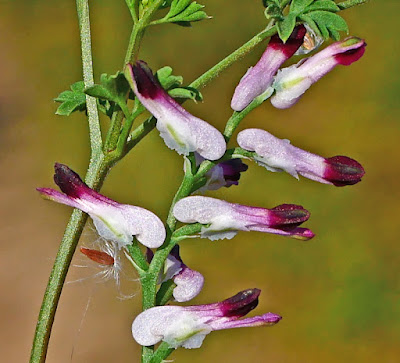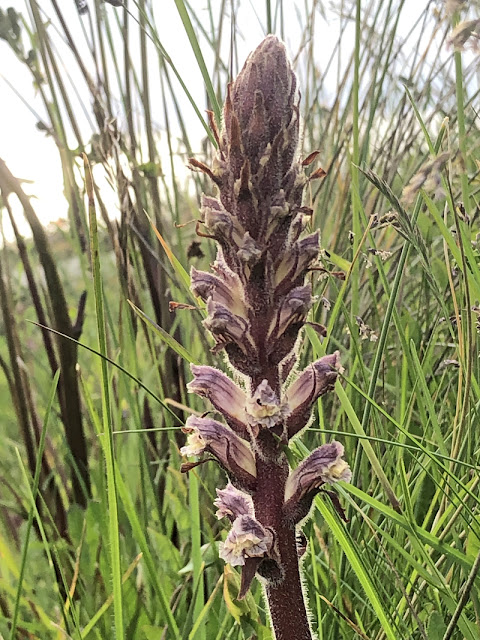May was perhaps the driest month for a long time with no measurable rain at all (this extended into mid June), so the annuals and early flowering species quickly shrivelled up and went to seed. I wondered what effect this might have on plants about to flower, but of course, our native plants are well adapted to periods of drought and seemed to cope well. The only obvious difference I have noticed, is that the very dry conditions means they flower and seed much quicker than usual, meaning that you might only see a plant in flower for a couple of weeks instead of for the whole month. Anyway, these are the highlights to round off my May finds in Cornwall.
I had never seen Water Avens, the species being absent from my previous home in the South East, so I made a trip "up North" to see it. I was of course, still in North Cornwall, but quite close to the Devon border. There are only a couple of places this species has previously been recorded and I knew it liked wet or damp conditions, so I concentrated my search near a small stream that ran by the road here. It took a while to find some, and only two plants were flowering. They are much nicer looking than their cousin Wood Avens, but more about those in a while.
Geum rivale
The issue with these populations is that they have hybridised with Wood Avens, which was flowering prolifically all over the area. Most plants I found were big and bushy with hybrid vigour and yellow petals, clearly the hybrid. To be sure, I had the Geum rivale above checked by an expert to determine it was the real deal and not a hybrid. Thankfully it was, but I think the hybrid is taking over at these sites to the detriment of the Water Avens itself.
Here's some photos of that hybrid. Note the yellow petals.
Geum rivale x urbanum = Geum x intermedium
Back on my local north Cornish coast and the Common Ramping Fumitory is back in flower, here at Pentireglaze cliffs.
Fumaria muralis
Last year I looked for, and failed to find Hairy Birdsfoot Trefoil. I put that right at Pentireglaze one afternoon. It has rich egg yolk coloured flowers only about half the size of Common Birdfoot Trefoil. Of course, it's a very hairy plant and looks a bit greyish from a standing height. It doesn't like competition, so grows in short turf or bare areas only.
Lotus subbiflorus
Here's what patch looks like from afar. Note how bare the ground is of other vegetation and the small, deep yellow coloured flowers. I found this quite quickly which was odd as I had looked over the same area last year and failed to find it. However, if not in flower, it could easily be missed.
Kidney Vetch was now flowering, and as usual on the North Cornwall coast there was a myriad of colour forms. There was the usual yellow, white, yellow and orange and these lovely red forms.
Anthyllis vulnareria var. coccinea
Cornwall is full of streams and streamlets which arise from faults in the bedrock, so even in drought, there are always wet flushes and damp valleys. Here's a fine display of wetland plants from such a streamlet.
In this area I found some Ragged Robin too. It's commonly spread around Cornwall, but I rarely see more than a few plants here and there.
Silene flos-cuculi
I was driving out of my local Tesco store when I noticed a patch of silver grey in the grass by the exit. I stopped and went back to look and found over a hundred Jersey Cudweed plants about to flower, lovely! This was right by the tyre inflation station with a lady inflating her tyres. She obviously thought I was mad, but she was actually quite interested when I showed her the plant.
Laphangium luteoalbum
On the last day of May, I took an evening trip to Rock Dunes and found Hairy Rock-cress, which had previously been recorded here. Oddly, I failed to find any in those previousy recorded areas, but I did find a dozen plants flowering at a new location in the dunes. I have seen these on chalk in Sussex and they are quite different. They are much taller here and the leaves are longer and do not clasp the stem as much as their chalk counterparts. They were too tall and thin to get a whole plant photo (about 30cm). Given the differences mentioned, I took the time to key them out properly in the botanist bible "Stace, 4th Edition" which confirmed the identification. Apparently they are quite variable species.
Arabis hirsuta
Viper's Bugloss is uncommon in Cornwall, but there's always some plants to see at Rock. I love their blue and pink flowers.
Echium vulgare
Atlantic Ivy is all over the dunes, though often buried under the sand. Making the most of this population was a huge number of Ivy Broomrapes which parasitise them. There were at least a thousand plants and most were the yellow form (they are usually purple).
Orobanche hederae
Yellow Rattle was abundant too in places, another hemi-parasitic plant that weakens grasses, allowing other less competitive species to grow.
Rhinanthus minor
The alien Hare's Tail Grass was super abundant here too in places.
It's flower head is soft like cotton wool to the touch.
Lagurus ovata
Mind Your Own Business is a common garden escaped plant here and probably all over the UK. This one below was growing on a sea cliff about a metre above the highest tide mark. What merits its inclusion here, is that this photo is the first one where I have managed to capture one of its minute flowers. It has no petals and is dead centre on the red stem.
Soleirolia soleirolii
There are so many amazing plants at Rock, but I'll make the next one the last for brevity. It's Sea Bindweed, but unlike its inland cousins, it doesn't climb up other plants. Its leaves are rounded and fleshy and can withstand being buried by shifting sand, only to pop up through it a few weeks later. They grow with Marram Grass in the sandy parts of dunes, usually closest to the sea, but above the high tide mark. Keep an eye out for them.
Calystegia soldanella
That's wraps up a very hot and dry May which continued well into June. But I have learned that our wild plants are very resilient and no doubt I will find some lovely plants in June too.
Until then, take care.
Dave





















































